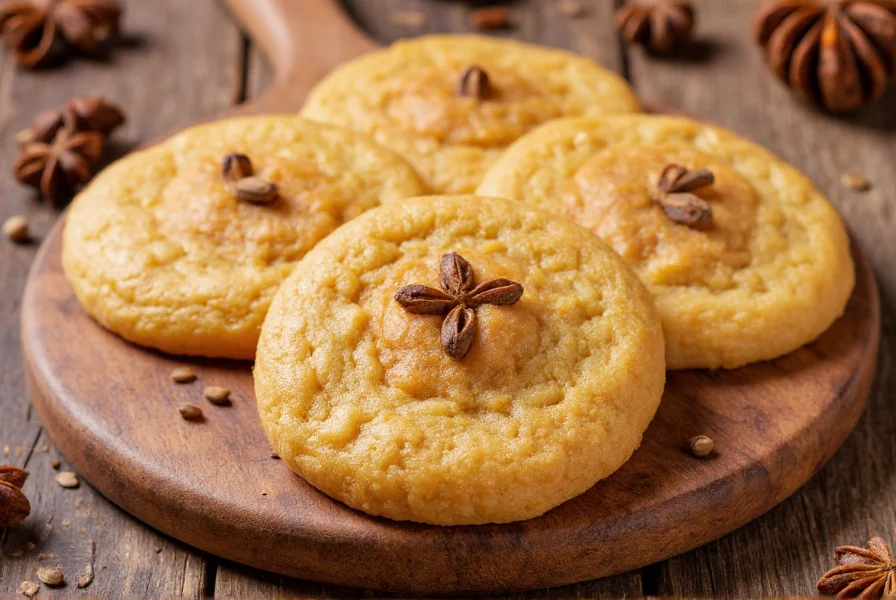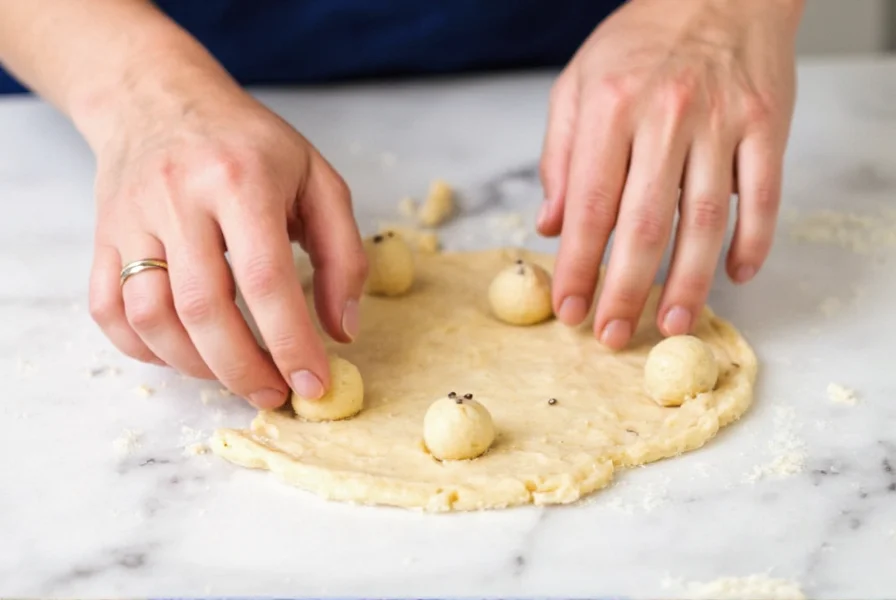Here's a classic anise cookies recipe that yields 24 soft, aromatic cookies with the perfect balance of sweet and licorice-like flavor: Combine 1 cup softened butter, 3/4 cup sugar, 2 large eggs, 2 teaspoons anise extract, 2 1/2 cups all-purpose flour, 1 teaspoon baking powder, and 1/4 teaspoon salt. Roll dough into 1-inch balls, dip in coarse sugar, and bake at 350°F (175°C) for 12-14 minutes until golden at the edges. These traditional anise seed cookies require just 20 minutes of preparation and deliver authentic Mediterranean flavor in every bite.
For centuries, anise cookies have graced tables across Mediterranean and European cultures, from Italian pizzelle to Greek koulourakia. These delicate treats carry the distinctive sweet-licorice flavor of anise seeds, which have been prized since ancient times for both culinary and medicinal uses. While modern bakers often reach for anise extract for consistent flavor, traditional recipes rely on freshly ground anise seeds for a more complex taste profile that transforms simple ingredients into something extraordinary.
The Science Behind Perfect Anise Cookies
Creating ideal anise cookies involves understanding how ingredients interact. The key to their signature texture lies in the creaming process—when you beat butter and sugar together, you're incorporating air bubbles that expand during baking, creating that tender crumb. Anise extract, being oil-soluble, distributes more evenly through the fat content than ground seeds would, ensuring consistent flavor throughout each cookie. For those seeking authentic anise cookies recipe results, room temperature ingredients are non-negotiable; cold ingredients won't emulsify properly, leading to dense, uneven cookies.

Traditional Anise Cookies Recipe
| Prep Time | Cook Time | Total Time | Servings |
|---|---|---|---|
| 20 minutes | 14 minutes | 34 minutes | 24 cookies |
Ingredients
- 1 cup (226g) unsalted butter, softened to room temperature
- 3/4 cup (150g) granulated sugar, plus extra for rolling
- 2 large eggs, room temperature
- 2 teaspoons pure anise extract (or 2 tablespoons freshly ground anise seeds)
- 2 1/2 cups (315g) all-purpose flour
- 1 teaspoon baking powder
- 1/4 teaspoon salt
- Coarse sugar or pearl sugar for rolling (optional but recommended)
Equipment
- Mixing bowls
- Electric hand mixer or stand mixer
- Baking sheets
- Parchment paper or silicone baking mats
- Cookie scoop or tablespoon
- Cooling rack
Step-by-Step Instructions for Authentic Anise Cookies
Preparing the Dough
- Cream butter and sugar: In a large bowl, beat softened butter and 3/4 cup sugar with an electric mixer on medium speed until light and fluffy (about 3-4 minutes). Proper creaming incorporates air that helps cookies rise properly during baking.
- Add wet ingredients: Beat in eggs one at a time, ensuring each is fully incorporated before adding the next. Mix in anise extract until completely combined.
- Combine dry ingredients: In a separate bowl, whisk together flour, baking powder, and salt to distribute leavening evenly.
- Mix dry into wet: Gradually add dry ingredients to wet ingredients, mixing on low speed just until combined. Overmixing develops gluten, which makes cookies tough rather than tender.
Shaping and Baking
- Chill the dough (optional but recommended): Cover and refrigerate dough for 30 minutes. This allows flavors to meld and prevents excessive spreading during baking.
- Preheat oven to 350°F (175°C). Line baking sheets with parchment paper or silicone mats.
- Shape cookies: Scoop 1-inch balls of dough (a #60 cookie scoop works perfectly). Roll each ball between your palms to create smooth spheres, then roll in coarse sugar if desired.
- Bake: Place cookies 2 inches apart on prepared baking sheets. Bake for 12-14 minutes until edges are lightly golden but centers still appear slightly soft. Rotate baking sheets halfway through for even baking.
- Cool completely: Transfer cookies to a wire rack immediately after baking. They'll firm up as they cool, developing their characteristic texture.

Proven Baking Tips for Perfect Anise Cookies Every Time
- Measure flour correctly: Spoon flour into your measuring cup and level off—don't scoop directly from the bag, which compacts the flour and leads to dry cookies
- Don't overbake: These cookies continue cooking on the baking sheet after removal from the oven. Take them out when edges are set but centers still look slightly underdone
- Use quality anise extract: Pure extract makes a significant difference compared to artificial versions. For traditional anise seed cookies, toast whole seeds in a dry pan for 1-2 minutes before grinding
- Consistent sizing: Use a cookie scoop to ensure uniform size, which guarantees even baking across all cookies
Delicious Variations to Try
While classic anise cookies are wonderful on their own, these easy adaptations let you customize based on preference or dietary needs:
- Gluten-free anise cookies: Substitute all-purpose flour with a 1:1 gluten-free baking blend. Add 1/4 teaspoon xanthan gum if not included in your blend
- Citrus-enhanced version: Add 1 tablespoon finely grated orange zest to the dough for a bright counterpoint to the anise flavor
- Cardamom-anise fusion: Incorporate 1/2 teaspoon ground cardamom for a sophisticated flavor profile common in Scandinavian baking
- Chocolate-dipped anise cookies: Once cooled, dip half of each cookie in melted dark chocolate for an elegant presentation
Storing and Serving Anise Cookies
Proper storage maintains the delicate texture of these traditional treats. Keep cooled cookies in an airtight container at room temperature for up to 5 days. For longer storage, freeze cookies in a single layer before transferring to freezer bags—they'll keep for 3 months. Thaw at room temperature for 30 minutes before serving.
Serve anise cookies with strong coffee or espresso to complement their distinctive flavor. They also pair beautifully with sweet dessert wines like Vin Santo, continuing the Italian tradition of biscotti con vino. For a special occasion, arrange them on a decorative platter with fresh figs or dried apricots for a Mediterranean-inspired dessert display.
Frequently Asked Questions
Can I substitute anise extract with star anise?
While star anise can work, it has a stronger, more complex flavor than regular anise. Use 1 whole star anise steeped in 1/4 cup warm milk for 15 minutes, then strain and use the infused milk in place of some liquid in your recipe. One star anise equals approximately 1 teaspoon anise extract.
Why are my anise cookies spreading too much?
Excessive spreading usually indicates butter that was too warm or insufficient flour. Ensure butter is softened but still cool to the touch, measure flour properly using the spoon-and-level method, and consider chilling the shaped cookies for 15 minutes before baking. High humidity can also cause spreading—add 1-2 tablespoons extra flour if needed.
How can I intensify the anise flavor without making cookies bitter?
For stronger flavor without bitterness, toast whole anise seeds in a dry skillet over medium heat for 1-2 minutes until fragrant, then grind finely. Use 2 tablespoons ground seeds plus 1 teaspoon extract. Avoid using more than 2 1/4 teaspoons extract total, as it can become medicinal-tasting at higher quantities.
Can I make these cookies vegan?
Yes, substitute butter with vegan butter sticks (not spreads), use flax eggs (1 tablespoon ground flaxseed + 3 tablespoons water per egg), and ensure your sugar is vegan-certified. The texture will be slightly different but still delicious. For best results with vegan anise cookies recipe, chill the dough thoroughly before baking.
What's the difference between anise, fennel, and star anise?
Anise (Pimpinella anisum) has the strongest licorice flavor and is used in Mediterranean baking. Fennel seeds are milder and more herbal, often used in Italian sausage. Star anise (Illicium verum) is a Chinese spice with a similar but more complex flavor. While interchangeable in some recipes, they have distinct flavor profiles—use anise seeds for authentic anise cookies recipe results.











 浙公网安备
33010002000092号
浙公网安备
33010002000092号 浙B2-20120091-4
浙B2-20120091-4